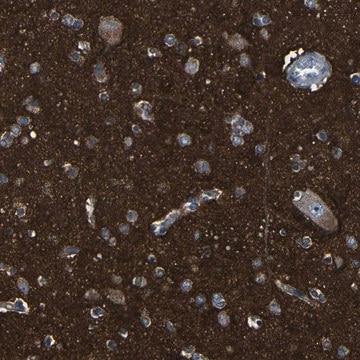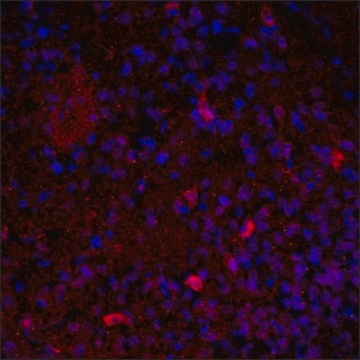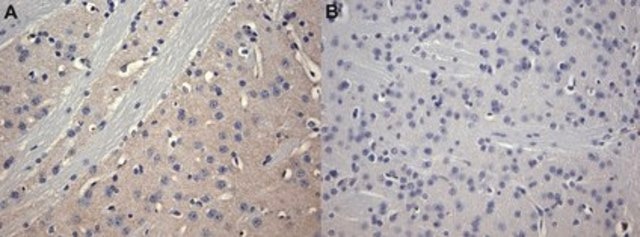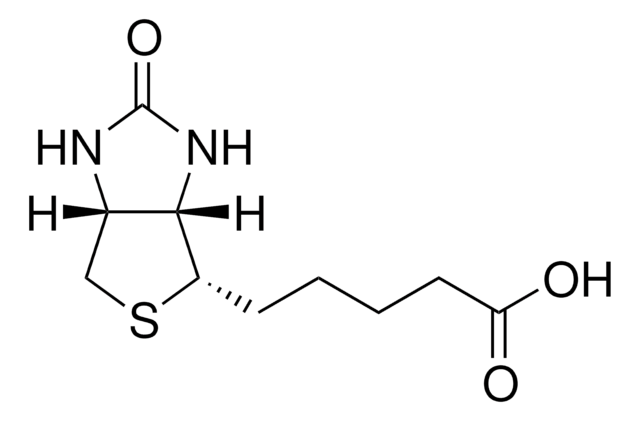AB1576
Anti-Cysteine String Protein Antibody
serum, Chemicon®
Synonym(s):
CSP, DnaJ Homologue Subfamily C member 5
Sign Into View Organizational & Contract Pricing
All Photos(1)
About This Item
UNSPSC Code:
12352203
eCl@ss:
32160702
NACRES:
NA.41
Recommended Products
biological source
rabbit
Quality Level
antibody form
serum
antibody product type
primary antibodies
clone
polyclonal
species reactivity (predicted by homology)
all
manufacturer/tradename
Chemicon®
technique(s)
western blot: suitable
NCBI accession no.
UniProt accession no.
shipped in
dry ice
target post-translational modification
unmodified
Gene Information
human ... DNAJC5(80331)
General description
Cysteine-string proteins are membrane-bound proteins associated primarily with nerve endings and synaptic vesicles in the brain where they serve an important role in presynaptic function and may be involved in calcium-dependent neurotransmitter release at nerve endings. CSPs posses a strech of amino acids highly enriched in cysteine residues that are post-translationally palmitoylated. CSPs may function as homodimers.
Specificity
Cysteine-string Protein. The antibody recognizes primarily the alpha isoform of CSP with some recognition of the beta isoforms. Slight reactivity with the gamma isoforms may be detected.
Immunogen
Recombinant rat cysteine-string protein with the cysteine string deleted.
Application
Immunohistochemistry on formalin fixed tissue: 1:1,000. (Recommend Cat. No. AB1576P).Immunocytochemistry on PC-12 cells: 1:1,000. (Recommend Cat. No. AB1576P).Immunoblotting: 1:5,000. CSPs should be resolved on 12-15% SDS-PAGE gels under NON-REDUCING conditions. CSPs typically migrate as 33-35 kDa species in vertebrate samples (dimers may also be seen). If one must perform SDS-PAGE under reducing conditions, it is necessary to alkylate the CSPs to prevent smearing.To ensure proper identification of CSPs, samples may be deacylated by treatment with 1M neutral hydroxylamine or 0.1M KOH in methanol resulting in a 6-7 kDa shift in electrophoretic mobility of the CSP band. Deacylation will usually result imn some loss of reactivity on western blots so sufficient protein should be loaded. Alternatively, because all CSPs appear to be acidic (approximate pI of 4.6-4.8) 2-D gel electrophoresis may be usefull to distinguish some CSPs. Finally, some sample treatments may cause partial deacylation of CSPs resulting in a smear of immunoreactivity below the mass of the fatty acylated monomer.Optimal working dilutions must be determined by the end user.
Research Category
Neuroscience
Neuroscience
Research Sub Category
Synapse & Synaptic Biology
Synapse & Synaptic Biology
This Anti-Cysteine String Protein Antibody is validated for use in WB, IC, IH for the detection of Cysteine String Protein.
Physical form
Liquid rabbit serum containing no preservatives
Storage and Stability
Store at -20°C in undiluted aliquots for up to 12 months from date of receipt. Avoid repeated freeze/thaw cycles.
Analysis Note
Control
POSITIVE CONTROL: brain samples
POSITIVE CONTROL: brain samples
Legal Information
CHEMICON is a registered trademark of Merck KGaA, Darmstadt, Germany
Disclaimer
Unless otherwise stated in our catalog or other company documentation accompanying the product(s), our products are intended for research use only and are not to be used for any other purpose, which includes but is not limited to, unauthorized commercial uses, in vitro diagnostic uses, ex vivo or in vivo therapeutic uses or any type of consumption or application to humans or animals.
Not finding the right product?
Try our Product Selector Tool.
wgk_germany
WGK 1
flash_point_f
Not applicable
flash_point_c
Not applicable
Certificates of Analysis (COA)
Search for Certificates of Analysis (COA) by entering the products Lot/Batch Number. Lot and Batch Numbers can be found on a product’s label following the words ‘Lot’ or ‘Batch’.
Already Own This Product?
Find documentation for the products that you have recently purchased in the Document Library.
Huzefa Rupawala et al.
Brain communications, 4(4), fcac192-fcac192 (2022-08-06)
In Alzheimer's disease, synapse loss causes memory and cognitive impairment. However, the mechanisms underlying synaptic degeneration in Alzheimer's disease are not well understood. In the hippocampus, alterations in the level of cysteine string protein alpha, a molecular co-chaperone at the
Cysteine string protein immunoreactivity in the nervous system and adrenal gland of rat
Kohan, S. et al.
The Journal of Neuroscience, 15, 6230-6238 (1995)
Laura Caló et al.
Brain : a journal of neurology, 144(6), 1661-1669 (2021-03-25)
α-Synuclein aggregation at the synapse is an early event in Parkinson's disease and is associated with impaired striatal synaptic function and dopaminergic neuronal death. The cysteine string protein (CSPα) and α-synuclein have partially overlapping roles in maintaining synaptic function and
Bruno A Benitez et al.
Acta neuropathologica communications, 3, 73-73 (2015-11-28)
Autosomal dominant adult-onset neuronal ceroid lipofuscinosis (AD-ANCL) is a multisystem disease caused by mutations in the DNAJC5 gene. DNAJC5 encodes Cysteine String Protein-alpha (CSPα), a putative synaptic protein. AD-ANCL has been traditionally considered a lysosomal storage disease based on the
Ching-Feng Chen et al.
Visual neuroscience, 39, E003-E003 (2022-05-12)
During the first postnatal week in rodents, cholinergic retinal waves initiate in starburst amacrine cells (SACs), propagating to retinal ganglion cells (RGCs) and visual centers, essential for visual circuit refinement. By modulating exocytosis in SACs, dynamic changes in the protein
Our team of scientists has experience in all areas of research including Life Science, Material Science, Chemical Synthesis, Chromatography, Analytical and many others.
Contact Technical Service






